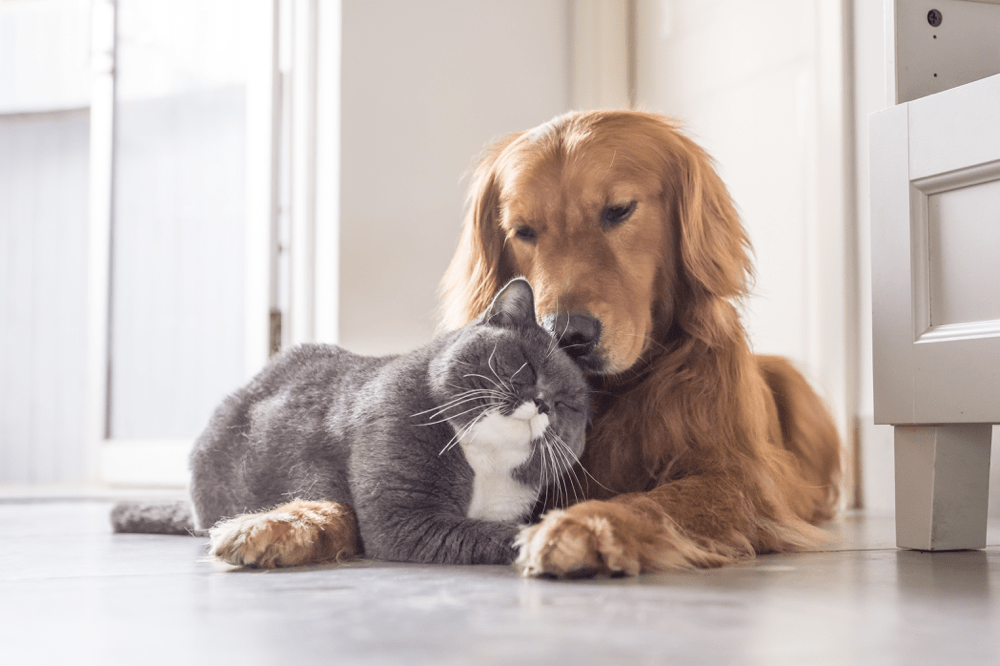When you bring your dog or cat to see the vet, the whole team does their best to make your pal feel comfortable—and that should include preventing fear or stress.
However, some practices go above and beyond by completing a special certification known as Fear Free.
Here’s why a Fear Free culture is beneficial to your pet…
What does Fear Free Certified® mean?
Even though your pet’s physical health is of the utmost importance during their vet visit, it’s important to consider their emotional wellbeing, too. In fact, studies show that anxiety, fear, and stress can lead to patients feeling more painful, being less responsive to medical treatments, and overall poorer medical outcomes.
That can make for a better veterinary experience and a calmer home life. Plus, it can lead to more enjoyment of the human-animal bond, which is part of what makes having a pet so special.
That’s why Fear Free was created—to help improve the mental and emotional wellbeing of pets everywhere.
Fear Free is a voluntary certification process with a focus on caring for your dog or cat’s mental and emotional health. Certification can be completed by individual veterinary team members, or by the entire hospital.
An individual who has achieved this title is referred to as a Fear Free Certified® Professional, and may include any members of a team from veterinarians to technicians and receptionists to managers. Non-veterinary professionals, such as pet sitters and groomers, may also seek certification.
A Fear Free Certified® Practice means an entire veterinary clinic has worked as a team to implement a thorough set of standards, and then passed an onsite inspection to verify that they follow Fear Free best practices.
Becoming a Fear Free Certified® Practice is an exciting achievement, because it means that everyone who works at the practice understands how to make the visit a more comfortable experience for your pet. It means the Fear Free culture underlies every part of a veterinary visit, from the lobby to communication, procedures, surgery, and beyond.
Why visit a Fear Free Certified® Practice?
Fear Free Certification creates the best veterinary experience for everyone, with a special focus on your furry friend’s point of view.
Everything your buddy experiences—including smells, noises, restraint methods, and more—are done in a way that minimizes fear, stress, and anxiety. If your pet is normally anxious during a vet visit, you may notice they’re significantly calmer and happier during a Fear Free visit.
That makes for a more pleasant veterinary experience, and helps prevent “white coat syndrome” (fear of a doctor visit) from escalating over time.
Here are a few things you may notice when you bring your pet to a Fear Free Certified® Practice…
- A calm, quiet place for procedures.
- Allowing enough time during the appointment for your pet to get used to the environment.
- Nonslip surfaces on floors and tables.
- The use of pheromone products and other methods to help pets feel calm and safe.
- Using treats to distract pets during anything they might find unpleasant, such as blood draws.
- Offering elevated platforms and hiding places for cats, so they feel more comfortable.
- Separate entrances and waiting rooms for dogs and cats, if possible.
- Observation of your pet and their body language for signs of fear or stress, so their experience can be improved.
- All team members exhibit calm behavior and “inside voices,” to avoid startling pets.
- Avoiding cleaners with residual odors that may bother sensitive dog and cat noses (remember, pets have a much stronger sense of smell than we do!).
- Clear communication to you as the pet parent, so the vet visit is comfortable for everyone.
Much like UrgentVet.com, some veterinary practices even implement Fear Free principles into the construction of the building itself, using soft lighting for a calming effect, or insulated walls to prevent too much background noise from medical equipment. Either way, you can rest assured your buddy’s emotional wellbeing is always front of mind.
The bottom line is, all of this is done in consideration of your pet’s safety and comfort level. The goal is to make a vet visit less stressful and more enjoyable.
Learn more about your furry friend’s emotional wellbeing
To learn more about Fear Free, including measures you can take at home to improve your pet’s mental stimulation and emotional happiness, visit the Fear Free website.
There, you’ll find tips you can implement at home right away. You can also do a search for veterinarians and hospitals in your city that are Fear Free Certified®.
Keep in mind that your local urgent care veterinary clinic, UrgentVet, is Fear Free Certified®.
Please visit your primary care (daytime) veterinarian for routine checkups and vaccines. But we’re here for any of your urgent concerns—such as vomiting, diarrhea, broken toenails, ear infections, etc.—after hours and during weekends and holidays.
You can learn more here, including how urgent care is different from emergency care.
As urgent care veterinary professionals, we tend to see dogs and cats when they’re not feeling well. Accordingly, we try our best to make them comfortable emotionally as well as physically. Besides healing their physical ailments, the prevention of stress and fear is a great way to help pets stay happy, healthy, and thriving!

